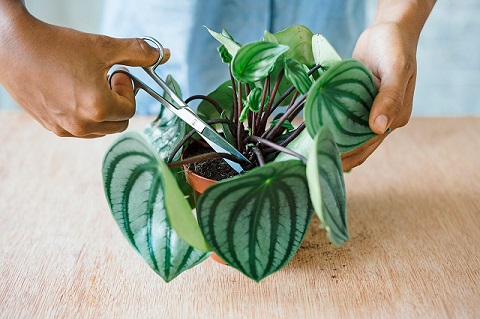
Are you captivated by the charming foliage and easy-care nature of peperomia plants? If so, you're in the right place! In this article, I'll share my expert tips and advice on how to properly care for a peperomia plant. Peperomia plants are a diverse and popular group of houseplants that are known for their beautiful leaves and low-maintenance requirements. Whether you're a new plant parent or an experienced green thumb, you'll learn everything you need to know about watering, lighting, humidity, soil, and more to keep your peperomia thriving. I'll also cover common issues and share propagation techniques so you can share the joy of peperomia plants with friends and family. Get ready to become a peperomia pro!
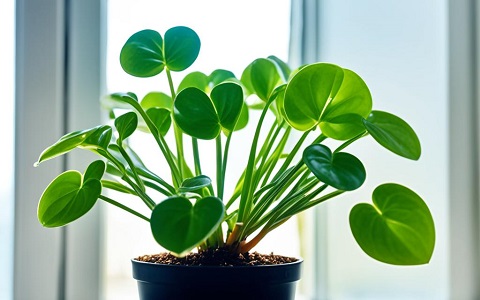
Key Takeaways
- Peperomia plants are diverse, easy-care houseplants with beautiful foliage
- Learn the essentials of peperomia care, including watering, lighting, humidity, and soil requirements
- Discover how to identify and solve common peperomia problems
- Propagate your peperomia plants to share the love with others
- Explore the wide variety of peperomia plant types and their unique care needs
Peperomia Plant Care
First, let's dive into the basics of peperomia plants. Peperomia is a large genus of small, succulent-like houseplants that are native to tropical and subtropical regions of the Americas. They come in a wide variety of peperomia varieties and peperomia plant types, with over 1,000 known species. Some of the most popular peperomia plant identification include Peperomia obtusifolia (baby rubber plant), Peperomia caperata (emerald ripple), and Peperomia clusiifolia (jelly peperomia).
Understanding the Peperomia Plant
Peperomia plants are known for their diverse foliage, ranging from round, oval, or heart-shaped leaves to those with intricate patterns and textures. These peperomia care essentials make them a popular choice among indoor gardeners. Whether you're a new plant parent or an experienced green thumb, understanding the unique characteristics of peperomia plants is the key to providing them with the best possible care.
Choosing the Right Peperomia Variety
With so many peperomia plant types and peperomia varieties available, it's important to select the one that best fits your growing conditions and preferences. Consider factors like leaf shape, color, and growth habit when peperomia plant identification. Some peperomia plants thrive in brighter light, while others prefer more moderate conditions. Researching the specific needs of your chosen peperomia variety will help ensure its long-term success.
Essential Peperomia Care Supplies
To keep your peperomia plant healthy and thriving, you'll need a few must-have peperomia care supplies. This includes a well-draining potting mix, a container with proper drainage, a spray bottle for misting, and a balanced, water-soluble fertilizer. Having these peperomia care essentials on hand will make it easier to provide your plant with the optimal growing conditions it needs.
Lighting Requirements for Peperomia Plants
Proper lighting is crucial for the health and growth of your peperomia plant. Peperomia plants thrive in bright, indirect sunlight. They prefer a spot near an east or west-facing window, where they'll receive 4-6 hours of bright, filtered light each day. Avoid direct, intense sunlight, as this can scorch the delicate peperomia leaves.
Bright, Indirect Sunlight: The Key to Success
Peperomia plants are adaptable to a range of lighting conditions, but they truly flourish when provided with the right amount of bright, indirect sunlight. This allows them to photosynthesize efficiently, promoting healthy growth and vibrant foliage.
Adjusting Light Exposure for Different Varieties
While most peperomia varieties prefer similar lighting conditions, some may have slightly different requirements. For example, the Peperomia caperata (emerald ripple) and Peperomia clusiifolia (jelly peperomia) can tolerate a bit more direct sunlight than the Peperomia obtusifolia (baby rubber plant). Experiment with the placement of your peperomia and monitor its response to find the perfect spot in your home.
Watering Your Peperomia Plant
When it comes to caring for your peperomia, proper watering is essential. These plants are susceptible to root rot if they are overwatered, so it's crucial to find the right balance and let the soil partially dry out between waterings. As a general rule of thumb, water your peperomia when the top inch or two of soil becomes dry to the touch.
How Often Should You Water Peperomia?
The frequency of watering for your peperomia will depend on factors like the variety, the size of the plant, the potting mix, and the environment. Typically, most peperomia plants need to be watered every 7-10 days during the growing season (spring and summer), and every 10-14 days during the dormant season (fall and winter).
Checking Soil Moisture Levels
To ensure you're not overwatering or underwatering your peperomia, it's important to regularly check the soil moisture levels. Stick your finger into the soil up to the second knuckle - if the soil feels dry, it's time to water. Conversely, if the soil is still moist, hold off on watering until it partially dries out.
Proper Watering Techniques
When watering your peperomia, be sure to use lukewarm, filtered water and apply it slowly and gently to the soil. Avoid getting water on the leaves, as this can promote fungal growth. Water until the soil is evenly moist, but not soaked or waterlogged. Discard any excess water that drains into the saucer beneath the pot.
Humidity and Temperature Needs
In addition to proper watering, maintaining the right peperomia humidity requirements is crucial for the health of your peperomia plant. Peperomia plants thrive in moderate to high peperomia ideal humidity, typically between 50-70%. This mirrors the naturally humid environments they're adapted to in their native tropical and subtropical habitats.
To create an ideal humidity level for your peperomia, consider using a peperomia misting technique. Lightly misting the leaves and soil a few times per week can help increase the surrounding peperomia care temperature. You can also group your peperomia plants together or place them on a pebble tray filled with water to boost the humidity in their immediate environment.
When it comes to temperature, peperomia plants prefer moderate, consistent warmth. Aim to keep their peperomia temperature needs between 65-85°F (18-29°C). Avoid exposing them to sudden temperature fluctuations or drafts, as this can stress the plants and lead to issues like leaf drop or stunted growth.
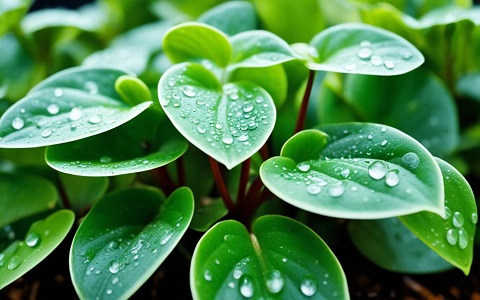
Soil and Potting Requirements
Peperomia plants have specific soil and potting requirements to thrive. They prefer a well-draining, aerated potting mix that is slightly acidic, with a pH between 5.5-6.5. A commercial cactus or succulent mix is an excellent choice, as it provides the ideal combination of peperomia soil requirements and nutrient retention.
Choosing the Right Potting Mix
When selecting a peperomia potting mix, look for a formula that is light, porous, and well-draining. Avoid heavy, dense soil mixes that can lead to waterlogging and root rot. The ideal peperomia potting mix should be a blend of ingredients like perlite, vermiculite, bark, and organic matter to ensure proper aeration and drainage.
Repotting Your Peperomia Plant
Peperomia plants generally don't require frequent peperomia repotting, but you may need to repot them every 2-3 years as they outgrow their containers. The best time to repot is in the spring or early summer, when the plant is actively growing. Choose a pot that is only slightly larger than the current one, as peperomia prefer to be slightly root-bound.
Avoiding Root Rot
One of the most common issues with peperomia plants is peperomia root rot, which can occur if the plant is overwatered or has poor drainage. To prevent this, ensure your peperomia container has adequate peperomia drainage holes, and use a well-draining potting mix. Regularly check the soil moisture and adjust your watering schedule accordingly to maintain the perfect balance for your peperomia's needs.
Fertilizing Your Peperomia Plant
Peperomia plants are not heavy feeders, but they do benefit from occasional peperomia fertilizer or peperomia plant food during the growing season. Understanding their peperomia nutrient needs and applying the best fertilizer for peperomia can help keep your plant thriving.
Understanding Peperomia Fertilizer Needs
During the spring and summer months, when peperomia plants are actively growing, apply a balanced, water-soluble peperomia fertilizer every 4-6 weeks. Dilute the fertilizer to half-strength to avoid potential peperomia plant food toxicity.
It's important to note that how to fertilize peperomia and when to fertilize peperomia can vary depending on the specific variety and growing conditions. Some peperomia may require more or less frequent feeding, so monitor your plant's response and adjust accordingly.
Best Fertilizers for Peperomia Plants
Look for a peperomia fertilizer that is formulated for houseplants or succulents, as these tend to have the right nutrient profile for peperomia. Avoid using a high-nitrogen fertilizer, as this can lead to leggy growth and decreased flowering. Instead, opt for a balanced formula with equal parts nitrogen, phosphorus, and potassium.
Some of the best fertilizer for peperomia plants include organic, water-soluble options like fish emulsion, liquid seaweed, or a diluted compost tea. These provide a gentle, steady supply of nutrients without the risk of overfertilization.
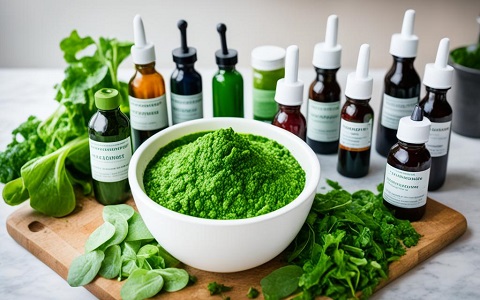
Pruning and Grooming Peperomia
Peperomia plants generally don't require frequent pruning, but a little grooming can help keep your plant looking its best. The best time to prune your peperomia is in the spring or early summer, when the plant is actively growing. This allows it to quickly recover and fill in any gaps left by the trimmed foliage.
When and How to Prune Your Peperomia
Use clean, sharp scissors or pruning shears to snip off any dead, damaged, or discolored leaves at the base of the stem. This helps maintain the plant's tidy, compact shape and encourages new, lush growth. Be careful not to remove more than a third of the plant's foliage at one time, as excessive pruning can stress the peperomia.
Removing Dead or Damaged Leaves
In addition to occasional pruning, regularly inspect your peperomia and remove any dead, yellowing, or damaged leaves. Gently grasp the leaf at the base and pull it away from the stem. This not only improves the plant's appearance, but also prevents the spread of disease or pests.
With a little peperomia pruning and grooming, you can keep your plant looking neat, tidy, and well-shaped. Remember to be gentle and avoid over-trimming, and your peperomia will continue to thrive and bring joy to your indoor space.
Common Peperomia Plant Problems
Like any houseplant, peperomia can occasionally face some challenges. The most common issues include pests such as mealybugs, spider mites, and aphids, as well as diseases like root rot and fungal infections. By staying vigilant and addressing problems quickly, you can keep your peperomia thriving.
Identifying and Treating Pests
Peperomia plants are susceptible to a few common pests, including mealybugs, spider mites, and aphids. These tiny insects can wreak havoc on your plant's foliage and overall health if left unchecked. Look for signs of infestation, such as webbing, sticky residue, or discolored leaves. If you spot any pests, act quickly to remove them and prevent further damage.
To get rid of mealybugs, spider mites, or aphids, start by wiping down the leaves with a damp cloth or spraying the plant with a mild insecticidal soap or neem oil solution. Be sure to thoroughly cover the undersides of the leaves, where pests often hide. Repeat this treatment every few days until the infestation is under control.
Diagnosing and Solving Common Issues
In addition to pest problems, peperomia plants may also struggle with issues like curling leaves, yellowing leaves, or drooping. These issues are often related to improper watering, lighting, or soil conditions.
If your peperomia's leaves are curling or turning yellow, it may be a sign of underwatering. Make sure you're allowing the soil to partially dry out between waterings, and adjust your watering schedule as needed. Conversely, if the leaves are drooping or the plant appears wilted, it could indicate overwatering and potential root rot.
To address these problems, start by thoroughly inspecting the roots and soil. If the roots appear mushy or discolored, it's time to repot the plant in fresh, well-draining soil. Adjust your watering routine to find the right balance for your peperomia's needs.
By staying vigilant and addressing peperomia pests and common care issues promptly, you can keep your plant healthy and thriving for years to come.
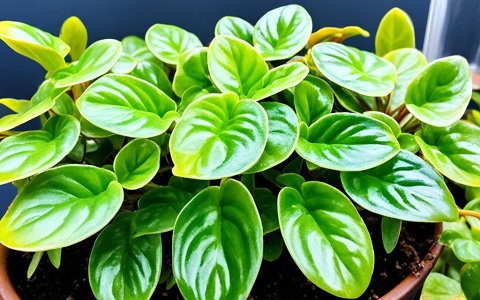
Propagating Peperomia Plants
One of the joys of growing peperomia plants is their easy propagation. You can readily grow new peperomia plants from leaf cuttings or stem cuttings, allowing you to share the love with friends, family, or expand your own collection.
Leaf Cuttings: A Simple Propagation Method
Taking peperomia leaf cuttings is a straightforward way to multiply your plants. Simply snip off a healthy leaf, making sure to include a small portion of the stem. Allow the cutting to dry for a day or two, then plant it in a well-draining potting mix designed for succulents or cacti. Keep the soil moist but not waterlogged, and within a few weeks, you should see new roots and growth emerging.
Stem Cuttings for Bushy Growth
For a fuller, more bushy peperomia plant, try propagating from stem cuttings. Select a healthy stem, cut it just below a leaf node, and remove the lower leaves. Plant the cutting in your peperomia-friendly potting mix, keeping the soil moist but not saturated. In time, the stem will develop roots, and new growth will sprout from the leaf nodes, giving you a robust, multi-stemmed peperomia plant.
Peperomia Plant Varieties and Care Tips
Peperomia plants come in a wide range of shapes, sizes, and colors, each with its own unique care requirements. Let's explore some of the most popular peperomia varieties and the specific tips for keeping them thriving.
Peperomia Obtusifolia (Baby Rubber Plant)
The Peperomia obtusifolia, commonly known as the baby rubber plant, is a classic choice for indoor gardeners. This variety features thick, succulent-like leaves that can grow up to 4 inches long. It prefers bright, indirect light and well-draining soil. Water the baby rubber plant when the top inch of soil becomes dry to the touch, being careful not to overwater.
Peperomia Caperata (Emerald Ripple)
The Peperomia caperata, or emerald ripple, is known for its stunning, heavily textured leaves that resemble a quilted pattern. This variety thrives in moderate to high humidity and prefers a slightly acidic, well-draining potting mix. Place the emerald ripple in a spot with bright, indirect light and water when the top inch of soil is dry.
Peperomia Clusiifolia (Jelly Peperomia)
The Peperomia clusiifolia, also called the jelly peperomia, is a unique variety with thick, succulent-like leaves that have a jelly-like appearance. This peperomia does best in bright, indirect light and prefers a well-draining potting mix. Water the jelly peperomia when the top inch of soil becomes dry, being mindful not to overwater.
FAQ
How often should you water peperomia?
When it comes to watering your peperomia, moderation is key. Peperomia plants are susceptible to root rot if overwatered, so it's important to let the soil partially dry out between waterings. As a general rule, water your peperomia when the top inch or two of soil becomes dry to the touch.
Do peperomias like to be misted?
In addition to proper watering, maintaining the right humidity levels is crucial for the health of your peperomia plant. Peperomia plants thrive in moderate to high humidity, typically between 50-70%. Misting your peperomia can help increase the humidity around the plant, which mirrors the naturally humid environments they're adapted to in their native tropical and subtropical habitats.
Do peperomia need lots of sun?
Proper lighting is crucial for the health and growth of your peperomia plant. Peperomia plants thrive in bright, indirect sunlight. They prefer a spot near an east or west-facing window, where they'll receive 4-6 hours of bright, filtered light each day. Avoid direct, intense sunlight, as this can scorch the delicate leaves.
How do you keep peperomia happy?
To keep your peperomia plant happy and thriving, be sure to provide the right balance of light, water, humidity, and soil conditions. Peperomia plants prefer bright, indirect sunlight, moderate watering, moderate to high humidity, and a well-draining, slightly acidic potting mix. Proper care and attention will help your peperomia plant stay healthy and vibrant.
Do you water peperomia from top or bottom?
When watering your peperomia, it's best to water from the top, allowing the soil to absorb the moisture. Avoid letting the plant sit in water, as this can lead to root rot. Check the soil moisture regularly and water when the top inch or two of soil becomes dry to the touch.



